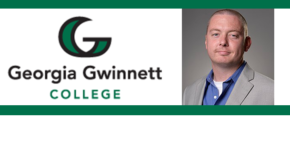 Getting a jumpstart on college courses can pay off for high school students
Getting a jumpstart on college courses can pay off for high school students
Wes Routon, associate professor of economics and quantitative analysis at Georgia Gwinnett College, discusses the benefits.
Dr. Wes Routon is an applied microeconomist with broad research interests, though much of his work falls within education economics, particularly the economics of higher education. Routon has been teaching economics and business statistics since 2009, and has taught at Georgia Gwinnett College since 2014. He enjoys teaching because it is fun and challenging, and he believes everyone can benefit from the economic way of thinking and statistical inference.
Dual Enrollment Pays Off
A “dual enrolled” student is one currently attending high school and additionally taking college courses at a nearby institution of higher education. For most students, these college courses are free of charge, with tuition and fees covered by publicly funded state programs. Many states have seen an upsurge in dual enrollment over the past decade. In Georgia, participation has almost doubled in the past 5 years alone, with public spending on these programs having more than doubled. Therefore, the state passed legislation that limits the number of dual enrollment credit hours a student may earn to 30, which translates to 8-10 courses in most cases.
Given the changes in program popularity, finance, and regulation, three colleagues and I examined the current state of dual enrollment in Georgia, with a focus on the economic benefit to students. A sample of about 2,000 dual enrolled students was collected for analysis. We found that, on average, these students save over $4,100 in tuition costs by participating in dual enrollment. If they would have otherwise financed those credit hours through a conventional, federal loan, that savings figure balloons to over $6,600. The average cost of a dual enrolled student to the state budget is just above $2,800, or at most 69% as big as the tuition savings.
The average student within the sample completed 18 college credit hours during their dual enrollment, a number greater than a traditional, full-time college semester. Students who later attended college full-time therefore graduated and entered the labor market approximately 4 months earlier than they would have in the absence of this program. On average, they earned almost $19,000 during that additional employment period, both significantly adding to the economic benefit they received from participation and reducing the cost to the state through increased income tax revenue.

Comments
2 responses to “Wes Routon, Georgia Gwinnett University – Dual Enrollment Pays Off”
Why not replace high school with college altogether? What’s the point of even having high school? You need to mention quality standards, student achievement, and all the other non-economic considerations.
Dual credit is definitely a great option that should be supported and made available for all high school students who “have the ability to benefit” (see: https://accuplacer.collegeboard.org/educators/ability-to-benefit). Once a student is proficient in algebra 1 and 9th-grade reading level (which additional support could be provided via summer and/or online programs during middle school and before high school) they are able to take and be successful in a number of college-level courses (e.g., general education courses, career/technical courses, etc.) while in high school. A key to the dual credit solution is to support (e.g., tuition waivers/reimbursement) and encourage (e.g., financial bonuses/course teaching preferences) existing high school teachers in attaining and hiring new high school teachers with the credentials to teach at the college level (i.e., a master’s degree in the discipline to be taught or a master’s degree in any discipline with 18-24 graduate credit-hours in the discipline to be taught). Many students who take the Advanced Placement (AP) tests do not obtain the 3 or above to attain college credit (see: https://apstudents.collegeboard.org/about-ap-scores/score-distributions). Thus, dual-credit would be more advantageous for students, and beneficial for teachers and schools. Why should students to take AP courses and then have to pay for the AP tests and then score a 3+ on the AP tests to get college credit when they take dual credit courses (which are often free to high school students)? With e-learning, ( live online courses, asynchronous online courses, blended/hyflex courses, etc.) teachers anywhere in the USA could have access to attaining the credentials to teach dual credit courses with the appropriate support and encouragement. More dual credit in high school could lead to a quicker, less expensive, efficient, and overall better quality of life in college degree/certificate attainment career entry/advancement. Scheduling for dual credit courses can be challenging due to scheduling (e.g., limited dual credit sections, sports, and other extracurricular events scheduled after school and on weekends, etc.). However, schools, parents, colleges, businesses/industry, and communities can collaborate to readily address the scheduling and other challenges.